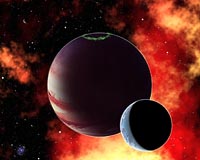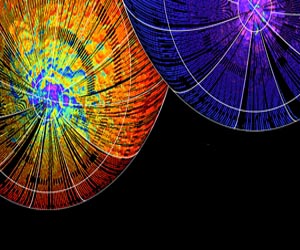|
 Most Extreme White Dwarf Binary System Found
Most Extreme White Dwarf Binary System FoundWarwick, UK (SPX) Mar 10, 2010 An international team of astronomers, including Professor Tom Marsh and Dr Danny Steeghs from the University of Warwick, have shown that the two stars in the binary HM Cancri definitely revolve around each other in a mere 5.4 minutes. This makes HM Cancri the binary star with by far the shortest known orbital period. It is also the smallest known binary. The binary system is no larger than 8 times the diameter of the Earth which is the equivalent of no more than a quarter of the distance from the ... read more |
. |
|
|
Free Space, Earth, Energy And Military Newsletters - Delivered Daily |
| . | . |
| .. |
First Of Missing Primitive Stars Discovered Boston MA (SPX) Mar 05, 2010
Boston MA (SPX) Mar 05, 2010Astronomers have discovered a relic from the early universe - a star that may have been among the second generation of stars to form after the Big Bang. Located in the dwarf galaxy Sculptor some 290,000 light-years away, the star has a remarkably similar chemical make-up to the Milky Way's oldest stars. Its presence supports the theory that our galaxy underwent a "cannibal" phase, growing ... more An Island Of Stars In The Making On The Outskirts Of Orion  Paris, France (SPX) Mar 04, 2010
Paris, France (SPX) Mar 04, 2010The delicate nebula NGC 1788, located in a dark and often neglected corner of the Orion constellation, is revealed in a new and finely nuanced image released by ESO. Although this ghostly cloud is rather isolated from Orion's bright stars, the latter's powerful winds and light have had a strong impact on the nebula, forging its shape and making it home to a multitude of infant suns. Starga ... more NASA's Fermi Probes "Dragons" Of The Gamma-Ray Sky  Washington DC (SPX) Mar 03, 2010
Washington DC (SPX) Mar 03, 2010One of the pleasures of perusing ancient maps is locating regions so poorly explored that mapmakers warned of dragons and sea monsters. Now, astronomers using NASA's Fermi Gamma-ray Space Telescope find themselves in the same situation as cartographers of old. A new study of the ever-present fog of gamma rays from sources outside our galaxy shows that less than a third of the emission aris ... more |
.. |
 How To Hunt For Exoplanets  Scientists now listen to the solar wind  Instant online solar energy quotes Solar Energy Solutions from ABC Solar |
.. |
|
|
Free Space, Earth, Energy And Military Newsletters - Delivered Daily |
|
|
. |
 NASA Radar Finds Ice Deposits At Moon's North Pole
NASA Radar Finds Ice Deposits At Moon's North PoleWashington DC (SPX) Mar 02, 2010 Using data from a NASA radar that flew aboard India's Chandrayaan-1 spacecraft, scientists have detected ice deposits near the moon's north pole. NASA's Mini-SAR instrument, a lightweight, synthetic aperture radar, found more than 40 small craters with water ice. The craters range in size from 1 to 9 miles (2 to15 km) in diameter. Although the total amount of ice depends on its thickness in each crater, it's estimated there could be at least 1.3 million pounds (600 million metric tons) of water ic ... read more |
| The contents herein, unless otherwise known to be public domain, are Copyright 1995-2010 - SpaceDaily. AFP and UPI Wire Stories are copyright Agence France-Presse and United Press International. ESA Portal Reports are copyright European Space Agency. All NASA sourced material is public domain. Additional copyrights may apply in whole or part to other bona fide parties. Advertising does not imply endorsement, agreement or approval of any opinions, statements or information provided by SpaceDaily on any web page published or hosted by SpaceDaily. Privacy statement |
| Previous Issues | Mar 09 | Mar 08 | Mar 05 | Mar 04 | Mar 03 |